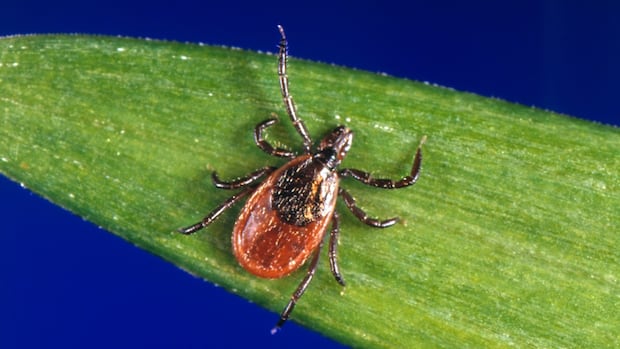Cases of Lyme disease and other tick-borne illnesses have been increasing in Quebec for more than a decade, and experts say climate change is partially to blame.
With increasing temperatures, ticks are becoming more established, especially in southern Quebec, said Kirsten Crandall, a scientific adviser with the Institut national de santé publique du Québec (INSPQ).
And with host animals moving north, be they birds or deer, ticks are covering a broader range, she said. This is especially true for black-legged ticks which can transmit Lyme, she added.
"I think we will definitely be continuing on that rise in the number of different tick-borne diseases," said Crandall. "Lyme disease obviously being the one with the most case numbers."
Lyme disease is caused by a bacterium transmitted by the bite of black-legged ticks. The first symptom is usually a single circular rash.
"Stage 2 and Stage 3 of Lyme disease can affect your heart, you can have neurological symptoms," said Dr. Donald Vinh, an infectious disease specialist at the McGill University Health Centre (MUHC).
"When it comes to those stages there are antibiotics, but they tend to be more intravenous types of antibiotics. So, it's really important to prevent it."
Number of cases risingThe number of declared cases of Lyme disease grew from 127 in 2014 to 653 in 2023. But not all were caught in the province. In 2014, 66 cases were acquired in Quebec. In 2023, that number jumped to 562, or 86 per cent.
Last year, there were 681 cases declared in Quebec, with 568 infections acquired in the province.
As of May 14 of this year, there were 61 reported cases, compared with 68 in the same period last year.
Jade Savage, an entomology professor at Bishop's University in Sherbrooke, said Quebec had an early spring last year, which meant ticks were active sooner. This year, spring has come later — meaning the ticks' activity is later.
Vinh said Quebecers should expect the annual totals to keep rising.
While increased forest excursions and not enough vigilance may play a role, Vinh said another factor is greater awareness among health-care providers that Lyme disease is now endemic in southern Quebec.
The black-legged tick population itself has also been growing.
Last year, the INSPQ mapped the projected spread to help communities and governments plan for the coming decades.
The maps show ticks expanding in areas where they are already found and into northern and eastern regions where they are not usually seen, including Saguenay, the Lower St. Lawrence and the Gaspé.
 The black-legged tick, known for carrying lyme disease, is much easier to spot as adults, usually later in the season. (Submitted by Vett Lloyd)
The black-legged tick, known for carrying lyme disease, is much easier to spot as adults, usually later in the season. (Submitted by Vett Lloyd)Crandall said rising temperatures will let tick populations thrive even in places that are typically cooler year-round.
Black-legged ticks can become active after just a few consecutive days above 0 C. Most Lyme infections are acquired in spring and early summer when young ticks are in the nymph stage and are much harder to spot than adult ticks.
Adult ticks are easier to see and are more active in the fall.
Crandall said Lyme disease's major endemic regions are the Outaouais, Montérégie and the Eastern Townships. She said cases are also cropping up along the St. Lawrence River valley.
According to the Health Ministry, there are only four Quebec regions where ticks aren't established: Côte-Nord, Nord-du-Québec, Nunavik and Terres-Cries-de-la-Baie-James. However, the ministry adds, not all established tick populations carry Lyme.
An established tick population is one that returns and continues to thrive after winter.
Less worry, more preventionWhile cases acquired in Quebec are rising, Crandall said Lyme disease isn't necessarily something to worry about, but it is something to adapt to. That's why the INSPQ and Health Ministry are working to educate the public about tick bite prevention, Crandall said.
Information about ticks, Lyme disease and tick bite protection can be found on the Health Ministry's website.
Savage launched eTick.ca in 2017 with INSPQ and the Public Health Agency of Canada. The tool, which works as an app or on the website, now serves the entire country, letting people report and identify ticks by uploading a photo. The site also offers advice on preventing bites.
Although 2025 tick reports are off to a slow start because of cooler weather and later spring, she does not expect that to affect the rest of the season. Last year saw a record number of submissions, though that partly reflects the app's growing popularity.
For every 100 submissions, as many as 75 per cent are identified as black-legged ticks. They continue to move into new areas, transported by birds, deer and other hosts, Savage said.
"They keep on expanding and they keep on being more numerous, but that is not necessarily a fully linear process," she explained.
"Some years, we will see more. Some years we see less. But the long-term trend all points to a continuous expansion."











